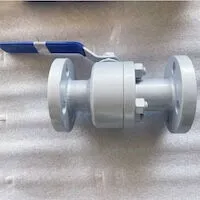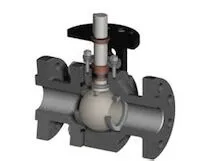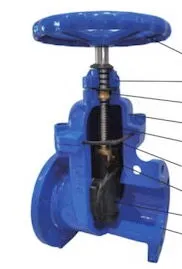Lifting Plug Valves
Oct 19, 2023
Lifting plug valves have various structural forms. Lifting plug valves are divided into soft seated plug valves and hard seated plug valves according to the material of the sealing surface. The basic principle is that when the valve is opened, the plug is raised and then rotated 90 degrees until the valve is fully open to reduce the friction with the valve body sealing surface; when the valve is closed, the cock is rotated 90 degrees to the closed position and then lowered to seal with the valve body sealing surface.
1. Double seal lifting plug valves
The double seal lifting plug valve has a soft seal structure. The plug body is a cylindrical plug body composed of three plates. The plates on both sides are inlaid with rubber sealing surfaces, and the middle is a cylindrical wedge plug.
When the plug valve is opened, the transmission mechanism causes the plug to rise, driving the two side plates to retract, causing the combined plug body and the valve sealing surface to separate, and then driving the plug body to rotate 90 degrees to the fully open position of the valve.
When the valve is closed, the transmission mechanism rotates the combined plug body 90 degrees to the closed position and then pushes the plug body down. The two side plates no longer move downward after contacting the bottom of the valve body. The middle wedge plug continues to fall, and the two side plates are pushed by the inclined plane. The phase inlet and outlet move so that the soft sealing surface of the side plate contacts the sealing surface of the valve body and is compressed to achieve sealing.
The double-sealing lifting plug valve has double blocking and discharge functions. The valve is equipped with a pressure balancing device to prevent abnormal pressure increase in the system and reduce the resistance at the moment of opening and closing of the valve. Because the metal surfaces of the sealing ring are in contact with each other after being compressed, the valve has a fireproof function. The maintenance of the valve is very convenient. The two side plates can be removed from the valve body and replaced by removing the end cap at the bottom of the valve body without disassembling the valve body from the pipeline. Therefore, it is also widely used in various industries such as petroleum, natural gas, metallurgical mining, gas engineering, light industry and textile, ship terminals, food and environmental protection water treatment for regulating, opening and closing the pipeline.
2. Hard seated lifting plug valves
The sealing surfaces of the valve seats on both sides of the metal seated lifting plug valve can be sealed, and the use of the valve is not restricted by the flow direction of the medium. When the metal seated lifting plug valve is closed, the handwheel and valve stem can be used to pressurize the valve seat’s sealing surface. By increasing the sealing specific pressure, the plug valve can have better sealing performance. The sealing surface of the valve seat is raised, which facilitates cleaning of the sealing surface. The sealing surface is not prone to the accumulation of crystallized media or solid particles. It is often used in high temperatures in chemical equipment. There are many structures of metal seated lifting plug valves, and there are two common ones, namely the handwheel handle lifting plug valve and mechanical cross drive lifting plug valve.
A. The working principle of the handwheel handle lifting plug valve is rising to fully open the plug and valve. When closing, first turn the handle to rotate the cock 90 degrees to the closed position, and then turn the transmission handwheel to lower the cock to achieve sealing.
When the valve is opened and closed again, the cock is separated from the valve seat, so the valve opens and closes very easily. The sealing surface is not easily scratched in the opening or closing process, and the valve has a long service life. However, the driving torque of the handle is small, so the nominal size of the valve used is usually not large. The handwheel handle lifting plug valve has a compact structure, small volume and low fluid resistance.
B. The working principle of mechanical cross-drive lifting plug valves is that when the valve is opened, the transmission device rotates the thread of the valve stem to make the plug body rise. After the sealing surface of the plug and the valve body are separated, the plug is driven to rotate 90 degrees until the valve is fully opened. When closing, the transmission device first rotates the plug 90 degrees to the closed position. After that, the plug no longer rotates. The driving force rotates the thread and causes the cock to descend, contacting the sealing surface of the valve body to achieve sealing.
1. Double seal lifting plug valves
The double seal lifting plug valve has a soft seal structure. The plug body is a cylindrical plug body composed of three plates. The plates on both sides are inlaid with rubber sealing surfaces, and the middle is a cylindrical wedge plug.
When the plug valve is opened, the transmission mechanism causes the plug to rise, driving the two side plates to retract, causing the combined plug body and the valve sealing surface to separate, and then driving the plug body to rotate 90 degrees to the fully open position of the valve.
When the valve is closed, the transmission mechanism rotates the combined plug body 90 degrees to the closed position and then pushes the plug body down. The two side plates no longer move downward after contacting the bottom of the valve body. The middle wedge plug continues to fall, and the two side plates are pushed by the inclined plane. The phase inlet and outlet move so that the soft sealing surface of the side plate contacts the sealing surface of the valve body and is compressed to achieve sealing.
The double-sealing lifting plug valve has double blocking and discharge functions. The valve is equipped with a pressure balancing device to prevent abnormal pressure increase in the system and reduce the resistance at the moment of opening and closing of the valve. Because the metal surfaces of the sealing ring are in contact with each other after being compressed, the valve has a fireproof function. The maintenance of the valve is very convenient. The two side plates can be removed from the valve body and replaced by removing the end cap at the bottom of the valve body without disassembling the valve body from the pipeline. Therefore, it is also widely used in various industries such as petroleum, natural gas, metallurgical mining, gas engineering, light industry and textile, ship terminals, food and environmental protection water treatment for regulating, opening and closing the pipeline.
2. Hard seated lifting plug valves
The sealing surfaces of the valve seats on both sides of the metal seated lifting plug valve can be sealed, and the use of the valve is not restricted by the flow direction of the medium. When the metal seated lifting plug valve is closed, the handwheel and valve stem can be used to pressurize the valve seat’s sealing surface. By increasing the sealing specific pressure, the plug valve can have better sealing performance. The sealing surface of the valve seat is raised, which facilitates cleaning of the sealing surface. The sealing surface is not prone to the accumulation of crystallized media or solid particles. It is often used in high temperatures in chemical equipment. There are many structures of metal seated lifting plug valves, and there are two common ones, namely the handwheel handle lifting plug valve and mechanical cross drive lifting plug valve.
A. The working principle of the handwheel handle lifting plug valve is rising to fully open the plug and valve. When closing, first turn the handle to rotate the cock 90 degrees to the closed position, and then turn the transmission handwheel to lower the cock to achieve sealing.
When the valve is opened and closed again, the cock is separated from the valve seat, so the valve opens and closes very easily. The sealing surface is not easily scratched in the opening or closing process, and the valve has a long service life. However, the driving torque of the handle is small, so the nominal size of the valve used is usually not large. The handwheel handle lifting plug valve has a compact structure, small volume and low fluid resistance.
B. The working principle of mechanical cross-drive lifting plug valves is that when the valve is opened, the transmission device rotates the thread of the valve stem to make the plug body rise. After the sealing surface of the plug and the valve body are separated, the plug is driven to rotate 90 degrees until the valve is fully opened. When closing, the transmission device first rotates the plug 90 degrees to the closed position. After that, the plug no longer rotates. The driving force rotates the thread and causes the cock to descend, contacting the sealing surface of the valve body to achieve sealing.
Previous: Pneumatic Valves Used in Cement Companies
Next: Hardening Process of Metal-seated Ball Valves


